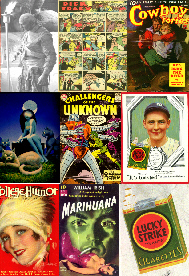|
|
|
chapter 1 2 3 4 5 6 7 8for image descriptions in this history hold your mouse over the imageBirth of the PulpThe history of pulp magazines is a convoluted tale of magazine publishing in America during the late 19th & early 20th century. Many falsely attribute the pulp magazine as the direct descendant of the dime novel, a small pocket sized book of about 150-200 pages that were generally tales of western outlaws such as Jesse James & Billy the Kid, or a pulp sized slim magazine of 48 pages or so. Though these dime novels are part of pulp history the direct progenitors of pulp were the slick magazines of the 1880's & 1890's. Magazines like the Century, McClure's & Munsey's Magazine were very popular during this period. In the 1890's these magazines were printed on heavy, slick paper and were about 7x10 inches in size - the size of a pulp mag! These magazines had some of the best writers & illustrators of the period. 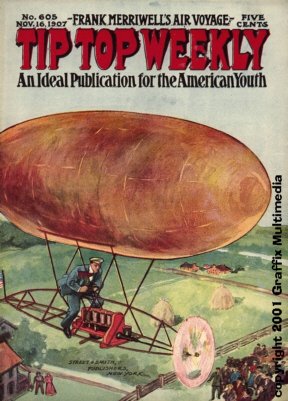
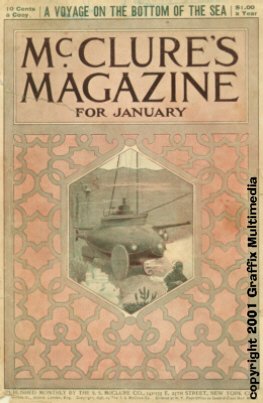 Publishers paid dearly for slick paper publication and these magazines sometimes sold for a whopping 50 cents or a dollar , quite a princely sum in those days. So the publishers started looking for more cost effective publication format as well as a way to print a magazine more available to those of less modest financial means. The answer was to use cheaper paper, or "pulp" thereby reducing printing costs & to use less popular or unknown artists & writers. The October 1896 issue of Argosy (published by American publishing legend Frank Munsey) is noted by some as the first true pulp magazine in format & content but I would say the change was more gradual than that, culminating in that issue being the final format change to the pulp style. The First WaveThe next major change that contributed to the growth of pulp publication was the use of unknown writers writing unconventional stories that could be bought cheaply & serialized in these pulps. The Argosy & the All Story as well as other titles would start one chapter of a story in the first weekly issue that would go for four weeks. The next week another story's first chapter would appear, then another the following ad infinitum so that each issue had a new cover feature & new story making the readers come back next week for the next chapter on and on. Probably the most well known writer who came around at this time was Edgar Rice Burroughs with John Carter in "Under the Moons of Mars" serialized in All Story from February to June 1912. This one story would help to lead pulps into their golden era of publishing which would culminate with the great period of hero, mystery & science fiction pulps that are so widely collected today. Shortly after this Frank Munsey published Burroughs "Tarzan of the Apes" in All-Story in the October 1912 issue. The cover painting by Clinton Pettee of Tarzan holding a lion in a headlock ignited pulp fiction in such a way that other publishers began with their own ventures. Street & Smith, previously a publisher of dime novels & hard cover books began publishing pulps in October 1915 with Detective Story Magazine (the first detective pulp) followed in July 1919 with Western Story Magazine. These two titles lasted for 1057 & 1285 issues respectively, making them among the longest runs in pulp history (Argosy lasted for more than 1600 issues in total with all it's title variations). Street & Smith would later go on to publish the Shadow & Doc Savage among many other titles. 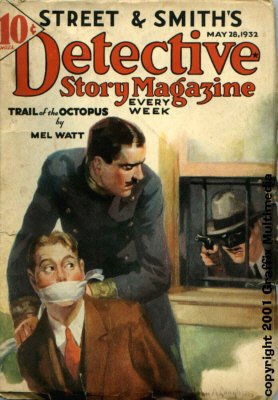
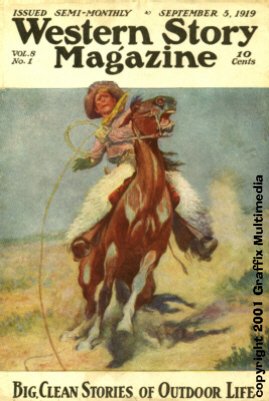 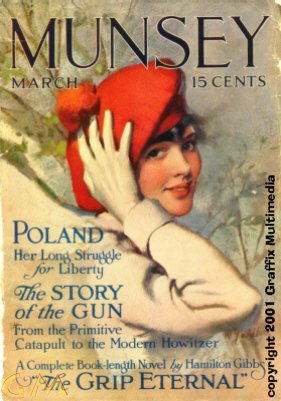 Detectives & VillainsThe Black Mask was the next big turning point in pulps. Unlike the other publishers, they were not afraid to pay more for the stories that appeared in the pulp title. This led to Dashiell Hammett's appearance in Black Mask for years with his Continental Op & Sam Spade tales and Raymond Chandler's short stories as well as a slew of other top notch hard-boiled authors. But more importantly it changed the direction of the pulp magazine by introducing regular characters in the stories. Ellery Queen, Sam Spade, John Dalmas (the Marlowe progenitor), Race Williams & others. It would not be long before the Shadow and then Doc Savage, the Spider, Operator 5, G-8, Dusty Ayres & many more would come onto the scene and the golden age of pulps would be upon us. In 1923 one of the most famous of the pulp titles would appear & help in another way to change pulp fiction. Argosy & the All-Story were multiple feature magazines. each issue would have a variety of genre stories including adventure, western, mystery, fantasy & ...... science fiction!! Science in the PulpsScience fiction novels had been around for decades by this time. Mary Wollstonecraft Shelley had published her book "The Modern Prometheus" also known as Frankenstein in 1816. This novel about the scientific reconstruction of life was the first of it's type, introducing the mad scientist into english culture, as well as the first form of "alien creature" in the electrically revived monster. But it would still be many years before the science fiction story would gain hold & coalesce into a firm style. Jules Verne, the French novelist wrote "A DRAMA IN THE AIR" in 1851 followed by "A JOURNEY TO THE CENTER OF THE EARTH" in 1864, and with them - the SF novel had now been defined. Verne's "FROM EARTH TO THE MOON" further defined the genre in 1865. From here it would just be short step to the stories of H.G.Wells, H.Rider Haggard & finally Edgar Rice Burroughs, A. Merritt, Phillip Wylie & others. But it would still take time before the first all-sceince fiction magazines would be published. First it would take a magazine of fantasy & horror stories to boost pulp fiction into the genre. They would call it Weird Tales.... 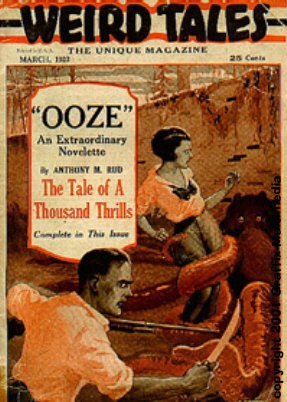 Strange BeginningsWeird Tales first appeared with it's March 1923 issue. But it was far from an immediate success. Publishers Jacob Clark Henneberger and J.M. Lassinger formed Rural Publications & hired newsman Edwin Baird to edit the magazine. But Baird proved to be a bad choice as editor & was replaced by Farnsworth Wright who had previously been first reader for the foundering publication, after author H.P.Lovecraft refused to move to Chicago and take over the helm of the pulp title. Farnsworth Wright's stewardship of Weird Tales slowly but surely led the maagzine into profitablity. His keen understanding of the medium allowed him to seek & find such famous fantasy authors as Lovecraft, Otis Adelbert Kline (who had also served as first reader), Tennesee Williams, Robert E. Howard, Seabury Quinn & a host of other top fantasy talents. The title almost ceased in 1930 when the publisher's lending bank was closed by the woes of the depression. But a few months of difficulty was soon forgotten. At the same time that Weird Tales was first appearing on the news stand, another publisher was about to make an equally important move that would impact strongly on the pulp magazine. Science & InventionIn the 1920's publisher Hugo Gernsback was putting out Radio News & Science and Invention. Broadsheet slicks, these were popular science magazines introducing Americans to the marvels of electronics & technological design. Looking for new properties & seeing the emerging pulp fiction medium as a viable publishing outlet, Gernsback's scientific interests were a fertile ground for creating a magazine containing entirely science-fiction, and Amazing Stories was born. next chapter: Science Fiction Gets A Home..Bibliography listing |
|
||||

This site created & maintained by Graffix
Multimedia ©1992-2014 no part may
be reproduced without permission of the author of this
site.
